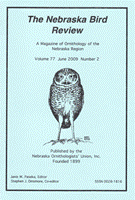Nebraska Ornithologists' Union

Nebraska Bird Review
Date of this Version
6-2024
Document Type
Article
Citation
Nebraska Bird Review, volume 92, number 2, June 2024, pp. 50–77
Abstract
A major concern this spring was the widely lamented shortfall in numbers of migrant warblers and the shortened duration of the migration, with most sightings relatively early. Numbers of migrant warblers east of the 100th meridian were investigated by Joel Jorgensen and Stephen Brenner and the scarcity was indeed found to be supported by eBird data; see the “News and Updates” section in Birds of Nebraska-Online (BONO). At Oliver Reservoir in the Panhandle, however, Steven Mlodinow found that migration was at least normal for a range of common migrants, with some migrants above the levels of the last four years.
Along with low numbers, the number of species arriving early statewide was mind-blowing; some 103 species tied or exceeded expected early arrival dates listed in BONO. Among these early dates, 12 were record early or 2nd-earliest. Of the 103 early arrivals, no fewer than 20 were warblers; 34 were nonpasserines. This tally continues and builds upon the 2023 early arrivals total of 29 species, thought at the time to be surprising. These early arrival dates suggest an overarching environmental effect pushing birds north earlier and concentrating numbers toward the early part of the migration window. Jorgensen and Brenner point out that leaf-out of trees and shrubs in the northern US and Canada where Nebraska migrants breed is getting earlier year by year, and it may be that migrants are adapting by moving north earlier and bunching up at these earlier dates in order to access the early leaf out and associated insects and other food items. It will be interesting and hopefully informative to see what spring 2025 brings.
Somewhat unexpected given the above were the late departures of about 20 species that winter in or near Nebraska, such as Iceland (Thayer’s) and Lesser Black-backed Gulls, Western and Harlan’s Red-tailed Hawks, Merlin, Peregrine Falcon, Ruby-crowned Kinglet, Brown Creeper, Hermit Thrush, Purple Finch, six sparrow species, and Rusty Blackbird. Why these would linger in contrast to the northward rush of 103 other species is hard to say.
Generally unrelated to arrival dates are interesting numbers of various species. Snow Geese numbers were startlingly low, probably due to early departure; the spring peak was only 15,000. On the other hand, 4500 Northern Shovelers was a record high spring tally, as were 200 Mourning Doves, 150 Chimney Swifts, an astounding 91 Whooping Cranes, and 37 Yellow-rumped Warblers. Low numbers are always a concern; in this group were Gray Partridge and Black-billed Magpie, the latter showing some intriguing fluctuations in the Panhandle. Perhaps of greater concern was the absence of the iconic Pinyon Jay; none have been reported since October 2023.
Distributional observations are of interest. Most are of eastern species westward, and this spring there was a Panhandle plethora of flycatchers, vireos, thrushes, and warblers that had fewer than 10 previous records there, most unexpected the 3rd spring records for each of Yellow-bellied Flycatcher, Gray-cheeked Thrush, and Northern Parula. Interesting westerly records of potential breeders were of Piping Plover at Lake Minatare, Scotts Bluff Co, 19 reports of Broad-winged Hawk in the Panhandle, and Pileated Woodpecker in Saline, Thayer, and Webster Cos. Western birds east are usually few; notable this spring were Western Wood-Pewee and Bullock’s Oriole.
Rarities are always fascinating; this spring there were several. Nebraska’s 2nd Eurasian Tree Sparrow was a fleeting visitor to a Nuckolls Co feeder, while others were a 2nd state record Type 5 Red Crossbill, 3rd state White Ibis, 3rd and 4th spring records of Gray Flycatcher, 6th Swainson’s (Russet-backed) Thrush, and 7th spring records of Brant and Virginia’s Warbler. A big surprise was Nebraska’s 11th Curve-billed Thrasher, in far north Sheridan Co no less.
Finally, a couple of oddities. A Mountain Plover banded in Kimball Co several years ago was “recovered by photo” twice in succeeding years, including this spring. For duck fans, a “White-necked” Gadwall was photographed, as was an American “Storm” Wigeon.
Included in
Ornithology Commons, Population Biology Commons, Poultry or Avian Science Commons, Zoology Commons


Comments
Published by the Nebraska Ornithologists’ Union, Inc.